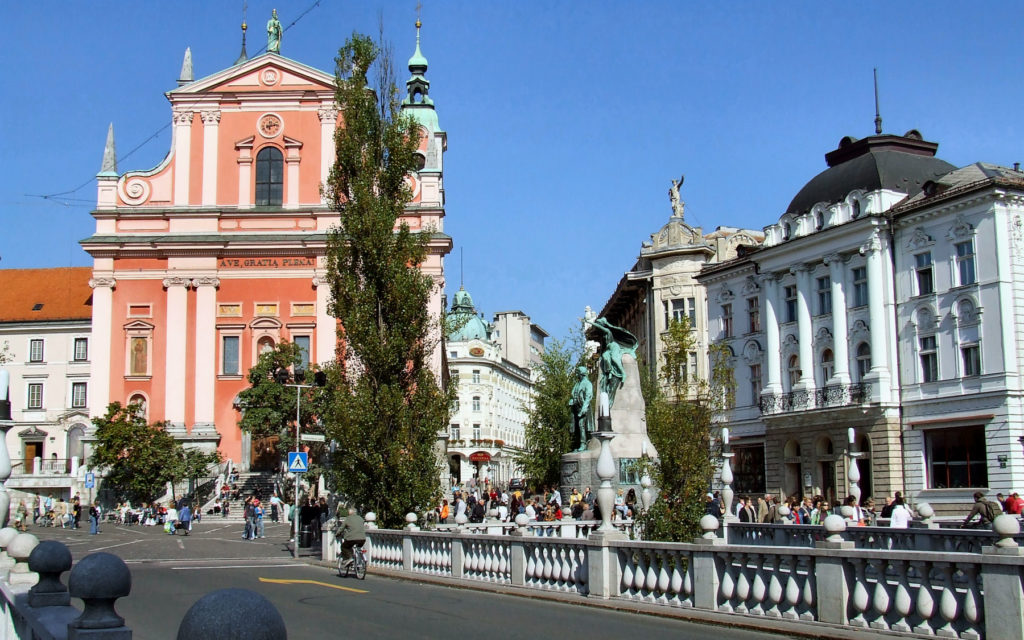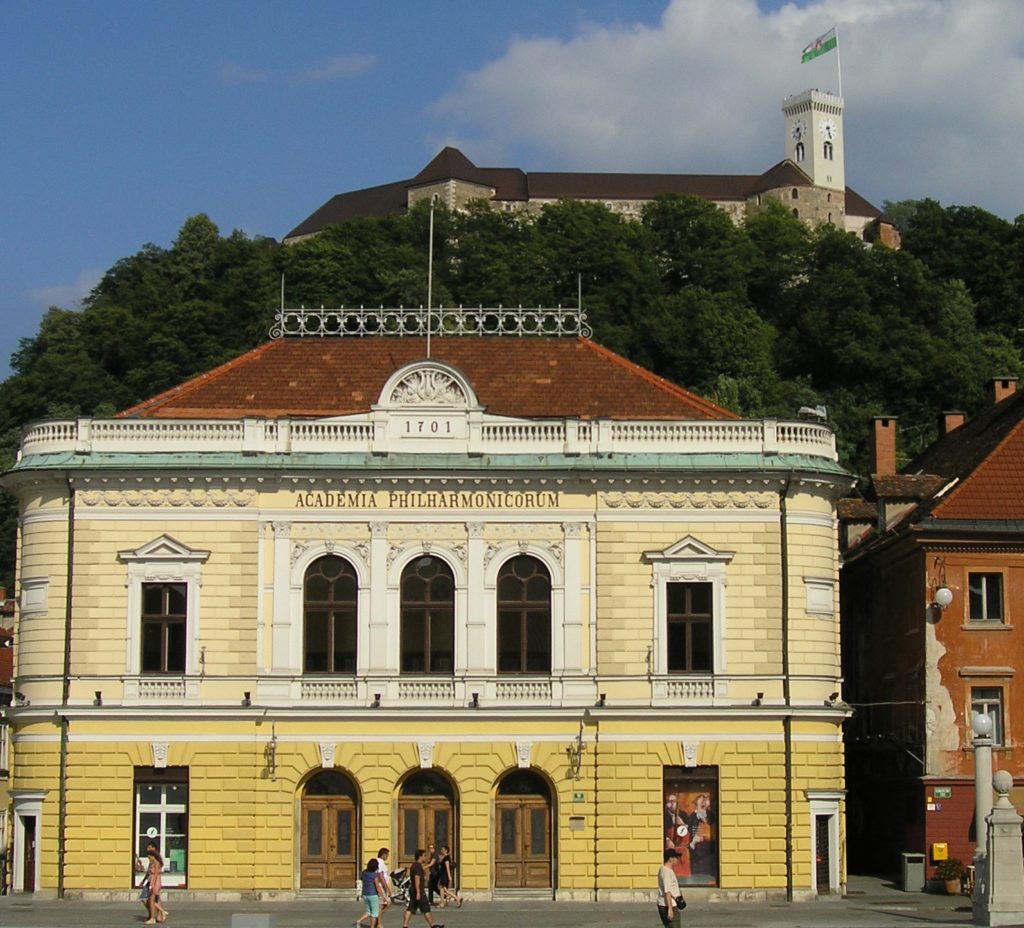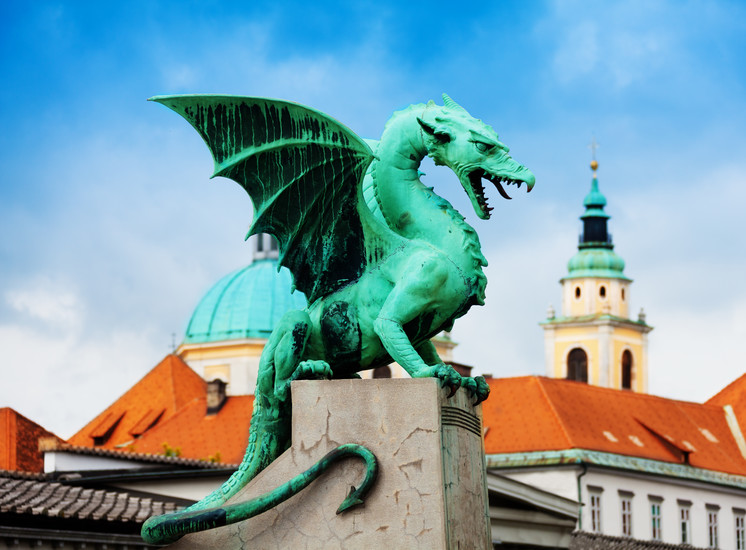When I ended the previous entry, our group was walking to Prešeren Square – named for France Prešeren – a 19th century Slovene Romantic poet who joined themes of his own unrequited love for his personal muse, Julija Primic, with that of an unhappy, subjugated homeland. In 1989, his poem Zdravljica (A Toast) which, according to our guide was a drinking song, was declared the Slovenian national anthem (sound familiar America?) and his likeness graces the Slovenian two-euro coin. An interesting statue of Prešeren sits on the eastern side of the square.
Please click on the photo to enlarge it and see the details. The Franciscan church dominates the photo but I want to point out some other elements. First, the photo was taken from the Triple Bridge (about which I’ll have more to say later). Now, look at the Prešeren monument just right of center and focus on the topless statue representing his muse Julija behind the poet. You also need to pay attention to the birch trees between the church and the monument. According to our guide, the bare breasted muse stirred a bit of local controversy with the women of the town expressing some consternation at the thought of their husbands being greeted by this sight upon exiting the church. The city’s solution, she told us, was to plant three birch trees thus obscuring the view. According to Wikipedia’s article about the monument, the three trees more prosaically indicate “the energy centre of Ljubljana” and the city’s tourism site says,
It’s no exaggeration to say that Prešeren Sqaure is not only the centre of Ljubljana, but truly the spiritual centre of the Slovene nation – and more practically the defacto meeting point in the city.
Still, accurate or apocryphal, I much prefer our guide’s explanation.
The building with the small green dome just behind the church is the Grand Union Hotel. On the far right, you can see a rather stately building that is the Ljubljana Central Pharmacy. The Neo-Renaissance edifice was once known as Mayer Palace and it was completed at the end of the 19th century. You can’t see the whimsical installation of the sprinkler that rains a light spray on a section of the square.
Dodging the mist, we walked two blocks or so to Congress Square. Interestingly, despite its being the capital of Slovenia, the square isn’t so named because any of the buildings surrounding it have anything to do with governing the country. Europe faced some turmoil after Napoleon’s defeat but the Great Powers had had enough of the battlefield and, at least for a time, sought to find a way to settle both problems and borders through negotiations instead of battles. This was known as the Concert of Europe or sometimes as the Congress System and it operated from 1815 until 1823 or so. The first great meeting was the Congress of Vienna in 1815 but there were subsequent meetings in Aix-la-Chapelle in 1818, Carlsbad in 1819, Troppau (today’s Opava in Czechia) in 1820, and in Laibach (recall that this is the Austrian name for Ljubljana) in 1821. The building
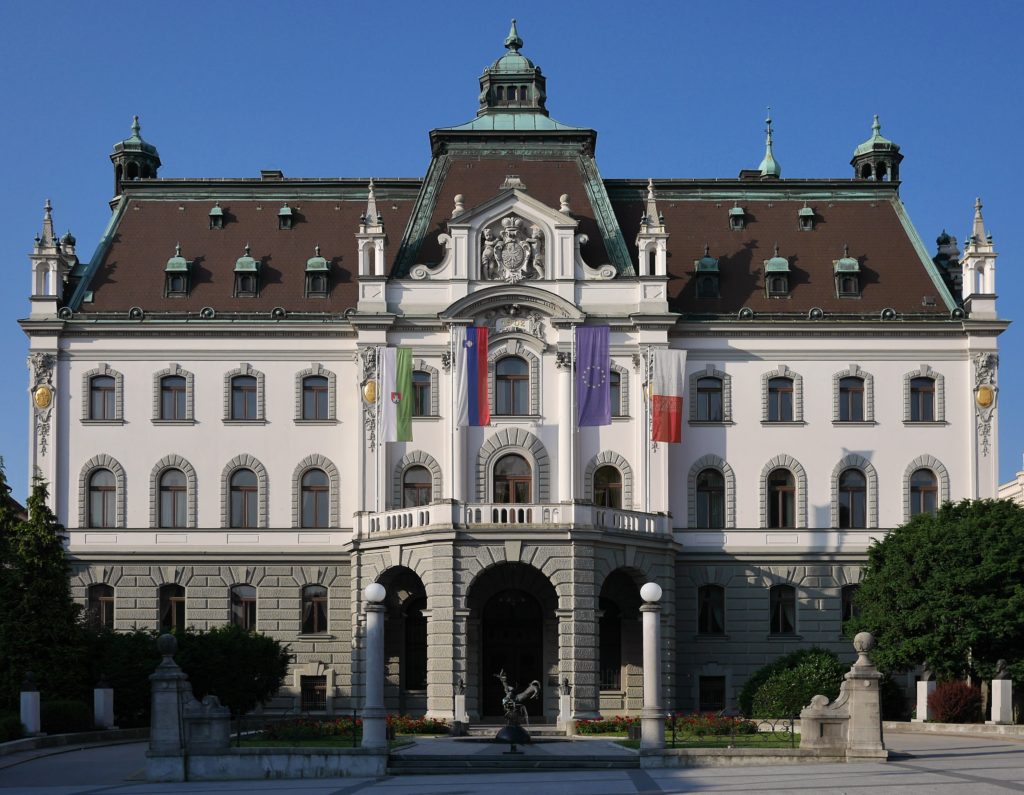 that hosted the Congress, and dominates the square’s south side, is now the central administrative building of the University of Ljubljana which is the oldest and largest university in Slovenia.
that hosted the Congress, and dominates the square’s south side, is now the central administrative building of the University of Ljubljana which is the oldest and largest university in Slovenia.
Another intriguing building on Congress Square is the Academia Philharmonicorum which, though it performed oratorios and other works of the time, was more a music organization rather than an actual orchestra. Its founding dates to 1701 making it Europe’s third oldest such body. In 1794 it became the Philharmonic Society or, in Slovenian, Filharmonična družba. Through the 19th century, the Music Society (Glasbena matica), a separate institution, also performed orchestral and choral works for the capital’s citizens. The two organizations officially merged in 1908 to form the Slovene Philharmonic Orchestra.
Behind the Academia building, you can see a part of Ljubljana Castle which scowls down on the populous from a hill high above the city. We’ll visit it later after one of our many crossings of the Ljubljanica River. For now, I want to briefly talk about the flag you see on the castle tower. The important image on the flag is the city’s coat of arms and the Ljubljana Dragon.
Several conflicting stories exist regarding the origin of the dragon as a symbol of Ljubljana. One ties to a Slavic myth that connects slaying a dragon with releasing the waters and ensuring the fertility of the earth. Another links to the tale of Jason and the Argonauts claiming Jason as the founder of the city and a third connects it with Saint George who was the patron saint of the Ljubljana Castle chapel built in the 15th century. Regardless, for Slovenians, the dragon symbolizes power, courage, and greatness.
The Ljubljana Dragon’s importance is further stressed by another of the three noteworthy river crossings, the Dragon Bridge. The bridge was built during the period of the city’s reconstruction following the 1895 earthquake and is considered the most beautiful bridge built in the Viennese Secession style. It’s a triple hinged arch bridge with four dragon statues standing on pedestals at its four corners and 16 smaller dragon statues adorning its 33-meter span. Here are photos of two of the dragons:
Although these photos aren’t ones I took, I did take pictures of each of the four main dragons and I had an interesting experience while I was lining up to take them. Two fellows approached me and, through their gestures, asked me to take their picture. That was it. We had no exchange of any information, no conversation, not even a handshake. I took their picture (for me, not for them), they waved at me, and went on their way.
As I noted above, I’m not going to strictly adhere to the chronology of my time in Ljubljana but I will close this entry with the end of my first day there. After our tour ended, Diane and I separated from the group and explored the city on our own. As we wandered about, we encountered two different wedding parties (shades of my Trans-Mongolian Express tour) using parts of the city as a backdrop for photos. Sadly, like all the others at this point, my pictures of the celebrants are among the missing. We also stumbled across an activity going on called MasterBall. It was an informal athletic contest of sorts and both spectators and visitors seemed to be having a grand time.
After watching for a while, we headed off to find a restaurant that had been high on my list of places to eat. Its name is Druga Violina which translates as Second Violin or, perhaps more colloquially as Second Fiddle. I wanted to dine here for a few reasons. First, it was well reviewed on some travel sites. Second, it’s menu centered on traditional Slovenian cuisine. But the third reason was, in fact, the most important.
Some of you know that the last stop of my working career was as the chief financial officer for the Arc of Prince George’s County. The Arc provides services and support to individuals with developmental disabilities and their families. I’d learned that Druga Violina was opened, at least in part, to provide employment opportunities to some in Ljubljana’s disabled community. On our music tour I learned that the expression “druga violina” carries some of the same connotations applying to the disabled as the expression second fiddle does in general usage in English.
We found it at the top of the Stari Trg (or Old Square)
and were fortunately able to grab a seat at an outdoor table because we watched a line of diners begin growing progressively longer shortly after we sat down. I ordered a traditional dish called Ajdova kaša z jurčki that roughly translates as “Buckwheat porridge with porcini mushrooms” and the delicious Violin salad.
Just opposite us (roughly from the direction of the photo above) a small band began to set up as we were finishing our meal. Because of the line, Diane and I were preparing to leave when the restaurant’s owner and founder (the red-haired woman in the far right of the photo below)
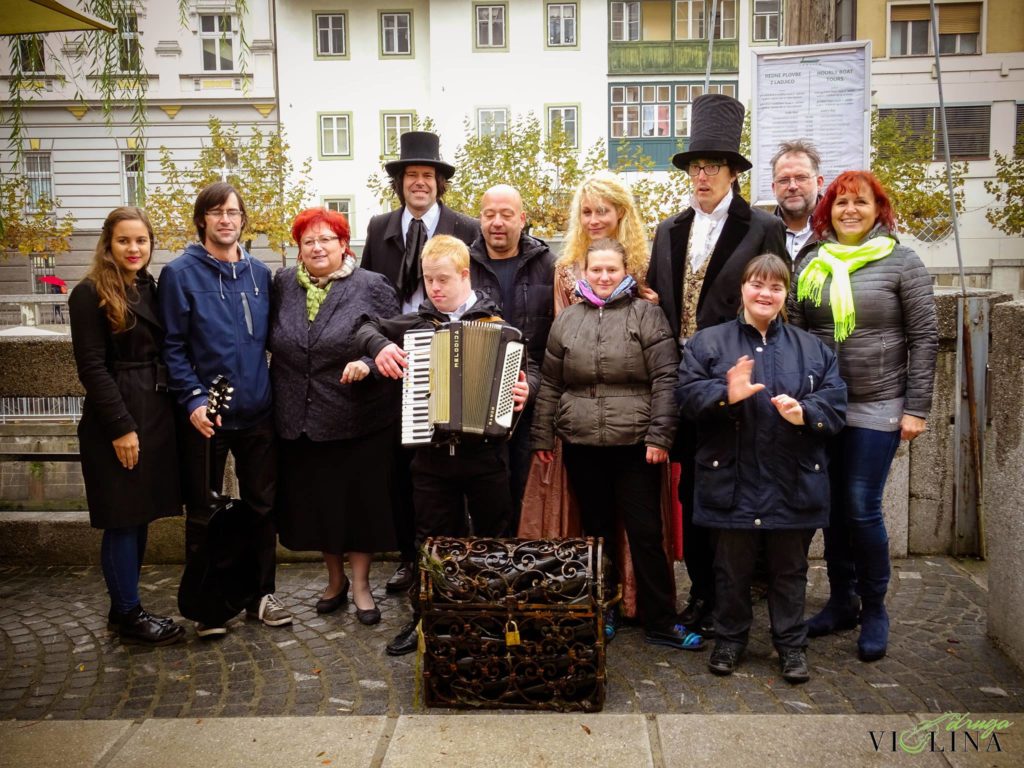 all but insisted we stay for the concert. As it turned out, we were able to both stay and free the table. We found a pair of open chairs that had been set up on the square and moved there. The group seemed to be from England and played a selection of tunes from early in the 20th century. During the concert, the owner spotted us and came over to tell us how happy she was that we’d stayed. It was a near perfect end to the day.
all but insisted we stay for the concert. As it turned out, we were able to both stay and free the table. We found a pair of open chairs that had been set up on the square and moved there. The group seemed to be from England and played a selection of tunes from early in the 20th century. During the concert, the owner spotted us and came over to tell us how happy she was that we’d stayed. It was a near perfect end to the day.
Tomorrow, we’ll visit Lake Bled and spend some more time in the charming capital city of sLOVEnia.
